Endocrine System
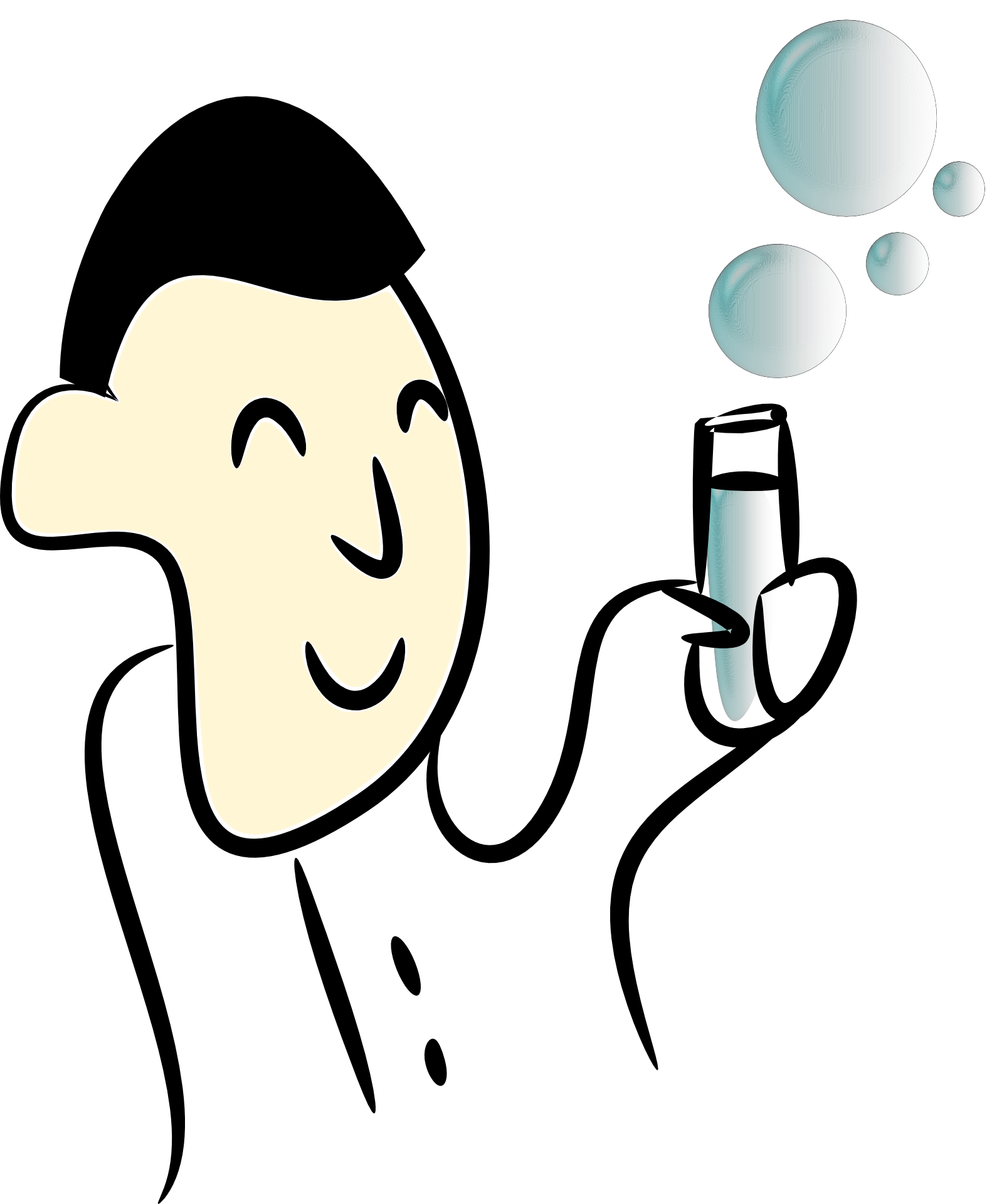

Homeostasis: The tendency of the body to maintain a relatively constant internal environment regardless of changing external conditions.
Hormone: Are signaling molecules, produced by glands in multicellular organisms that are transported by the circulatory system to target distant organs to regulate physiology and behavior.
Gland: A group of cells in an animal's body that synthesizes substances (such as hormones).
Endocrine glands: Glands that secrete substances into the bloodstream (e.g. pituitary gland).
Exocrine glands: Glands that secrete substances into a body cavity, or on its outer surface (e.g. Pancreas and salivary glands). Note, in this case, that the pancreas is both endocrine and exocrine, but this will be discussed in a later section.
As indicated previously, the typical mode of signaling of endocrine system is endocrine signaling, which involves substances secreted into the bloodstream and transported to distant target organs. Other modes include Autocrine (secreted substances bind to the receptors on the same cell), Paracrine (Targets cells in the same tissue of organ) or Juxtacrine (utilize oligosaccharide, lipid, or protein components of a cell membrane to target same [emitting cell] or adjacent cells).
Protein Hormones (such as Growth hormone): These hormones travel to a target organ, tissue or cell and do not enter the cell. Instead, they attach to receptors on the cell membrane which causes enzymes to become activated inside the cell.
Steroid Hormones / Steroids (such as Estrogen): These are able to cross the cell membrane and enter the nucleus of a cell. They cause effects on the target organ through regulation of gene expression.

The mechanism of action of protein and steroid hormones. a ~ Hormone, b ~ plasma membrane. c ~ cytoplasm, d ~ nucleus. Steroid hormones bind receptors inside the nucleus and cause DNA transcription, while protein hormones bind receptors on the plasma membrane resulting in signal transduction pathways that eventually result in gene expression in the nucleus. (Source: Wikipedia, CC BY-SA 3.0)
Homeostasis is the tendency of the body to maintain a relatively constant internal environment regardless of a changing external conditions. Homeostatic systems operate by means of feedback loops.
Negative feedback mechanism: A response by which the output of a system suppresses or inhibits the activity of the system.
Positive feedback mechanism: The output of the system accelerates or enhances the output created by a stimulus.
The hypothalamus regulates the pituitary gland (the master gland), through nerve stimulation from the brain, or, through release of hormones. In response to either mechanism, the pituitary then stimulates an endocrine gland to secrete a hormone. High levels of the hormone will eventually trigger a negative feedback that will affect the nerve activity of the hypothalamus resulting in a reduced activity, and as a result, reduced production of the hormone.
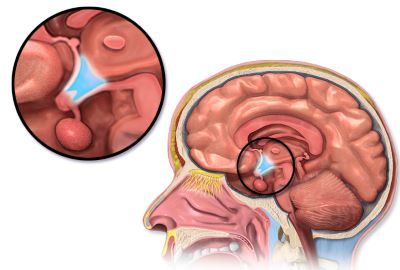
The location of the hypothalamus in relation to the rest of the brain. (Source: Wikipedia-CC BY-SA 3.0). Originally from: WikiJournal of Medicine 1 (2). DOI:10.15347/wjm/2014.010. ISSN 2002-4436.
The hypothalamus synthesizes hormones called releasing hormones, which travel to the pituitary gland and signal another specific hormones to be released. Examples of Releasing Hormones:
The Pituitary is also called the 'Master gland' as it controls other endocrine glands. It is a small sac-like gland about the size of a pea located in the brain where it is connected by a stalk to the hypothalamus. The pituitary is composed of 2 separate lobes (posterior and anterior)
The posterior lobe stores and releases hormones produced by the hypothalamus specifically Antidiuretic hormone (ADH) and Oxytocin. The Anterior lobe releases hormones in response to the releasing hormones produced by the hypothalamus.
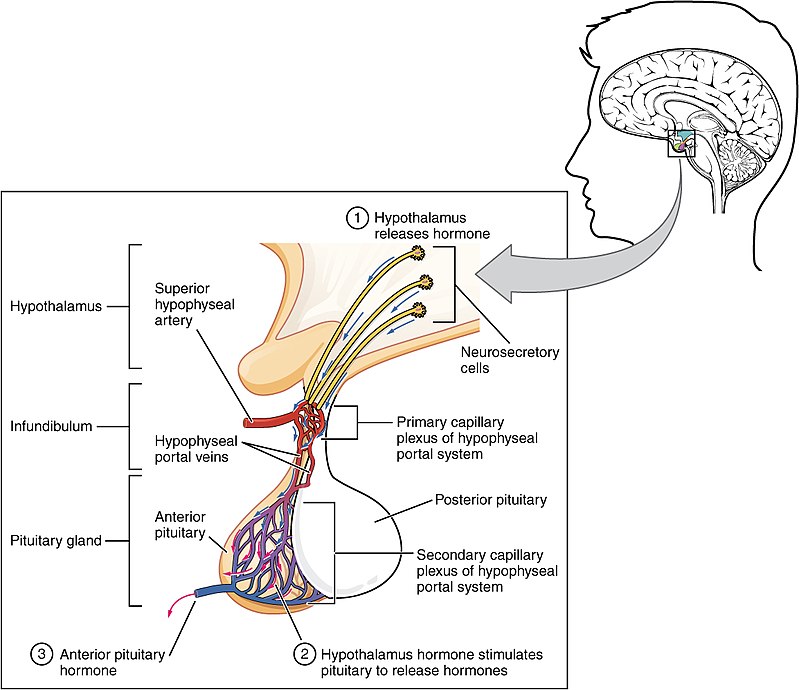
A detailed illustration of the pituitary gland. (Source: Wikipedia-CC BY-SA 3.0 and OpenStax College - Anatomy & Physiology, Connexions Web site.)
Pituitary Hormones and their functions include:
Posterior Pituitary
Anterior Pituitary
The body ensures the blood sugar (i.e. glucose) levels are maintained relatively constant between 3.5 and 8 mmol/lt. Blood sugar levels lower than normal result in a condition called Hypoglycemia, while higher than normal levels are called Hyperglycemia. As expected, blood sugar levels increase during the day, associated with the three main meals, and then it gradually reduces at night.
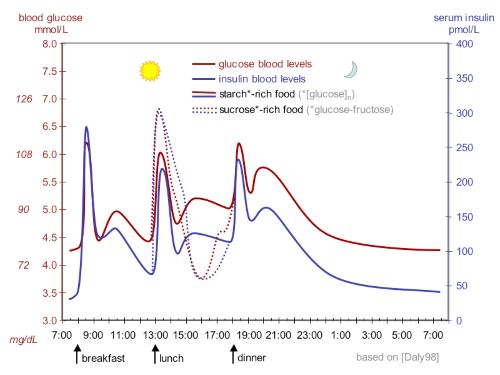
The relationship between feeding/eating times and blood sugar and insulin levels. (Source: Daly et al. 1998 PMID:18508724; CC BY 3.0)
The Pancreas
The Pancreas is partly an exocrine gland as it secretes digestive enzymes through the pancreatic duct (also called duct of Wirsung) that delivers the pancreatic juice to the small intestines, (see 'the digestive system' for more details). As an endocrine gland, the islets of Langerhans in the pancreas contain Beta cells that secrete Insulin and Alpha cells that secrete glucagon.
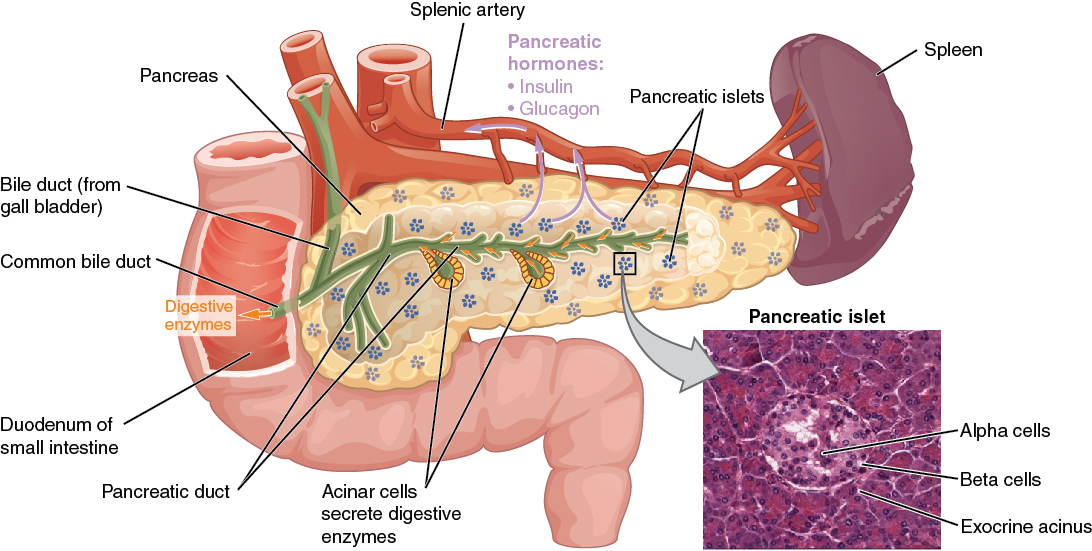
An illustration of the pancreas. (Source: Henry Vandyke Carter and Henry Gray (1918) Anatomy of the Human Body, Public Domain)
Insulin ultimately results in the reduction of blood sugar levels by: increasing the cell's permeability to glucose, thereby reducing the blood glucose levels. Insulin also results in the storage of glucose in form of glycogen, in the liver. Insulin is therefore essential after meals to ensure that the glucose from starch digestion does not cause hyperglycemia.
Glucagon is released when blood sugar levels are low. It stimulates the breakdown of glycogen to glucose, in the liver, and the glucose enters the blood to increase the sugar levels. This is necessary during fasting, or during physical exercise where the demand for glucose is higher than that being supplied from the diet.
Negative Feedback Loops
When blood sugar levels increase, insulin is secreted by the pancreas and results in three main effects. Firstly, glucose is converted t=in the liver to form glycogen which is stored. In the muscle cells, glucose is also converted to glycogen to be used when needed, such as during exercise. In adipose (fat) tissue, glucose is used to form fat, which is also stored.
When blood sugar levels are low, the pancreas secretes Glucagon, which results in the conversion of glycogen in the liver and muscles to glucose, and the breakdown of fat back to glucose.
Diabetes is characterized by chronic hyperglycemia because of either low production of insulin, or failure of the body to respond to the insulin being produced. The symptoms of Diabetes include higher than normal glucose levels in urine. This results in water retention in urine, causing frequent excessive urination and thirst. Diabetics have low energy levels. This is ironical because they have high glucose levels in blood. Low energy occurs because cells are unable to become permeable to glucose due to lack of insulin. As a result, the body switches to proteins & fats to metabolize as a source of energy. Over reliance on fat for energy results in the production of ketone bodies (such as acetone), which results in a condition called Ketoacidosis. Presence of ketone bodies in urine results in a condition called Ketonuria
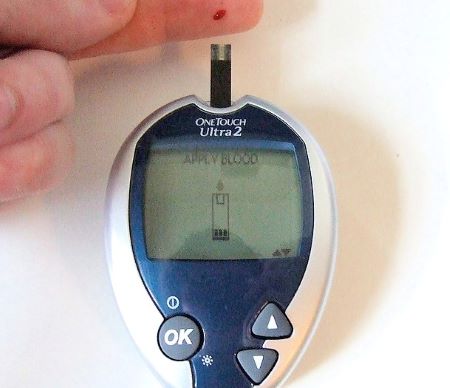
Blood glucose testing, showing the size of blood drop required by most modern meters. (Source: Wikipedia-CC BY-SA 3.0)
Type I is also referred to as Insulin dependent diabetes or Juvenile diabetes. It is an autoimmune disease where antibodies attack and destroy the beta cells of the pancreas. Symptoms occur at a younger age before puberty. It can be treated by insulin shots.
Long-Term Effects of Hyperglycemia include Atherosclerosis, Stroke/Heart attack, Kidney failure, Gangrene, Blindness, Nerve damage. Diabetics also run the risk of becoming hypoglycemic due to insulin shock.
This type of diabetes is not insulin dependent. It mostly develops in adulthood and is caused by an abnormally low number of insulin receptors on the cell surface. Most patients (90%) are over-weight so this type of diabetes can be controlled through dieting and exercise. Some medications such as Sulfonamides can be administered.
Hormones during pregnancy may promote insulin resistance resulting in a transient condition called gestational diabetes. The baby is usually born fine, without Diabetes, and the mother gets back to normal after giving birth. Mothers who develop gestational diabetes are at a higher risk of developing Type II diabetes later in life.
The stress response is controlled by the Adrenal Glands, which are located just adjacent to the kidneys. The adrenal glands comprise of two layers
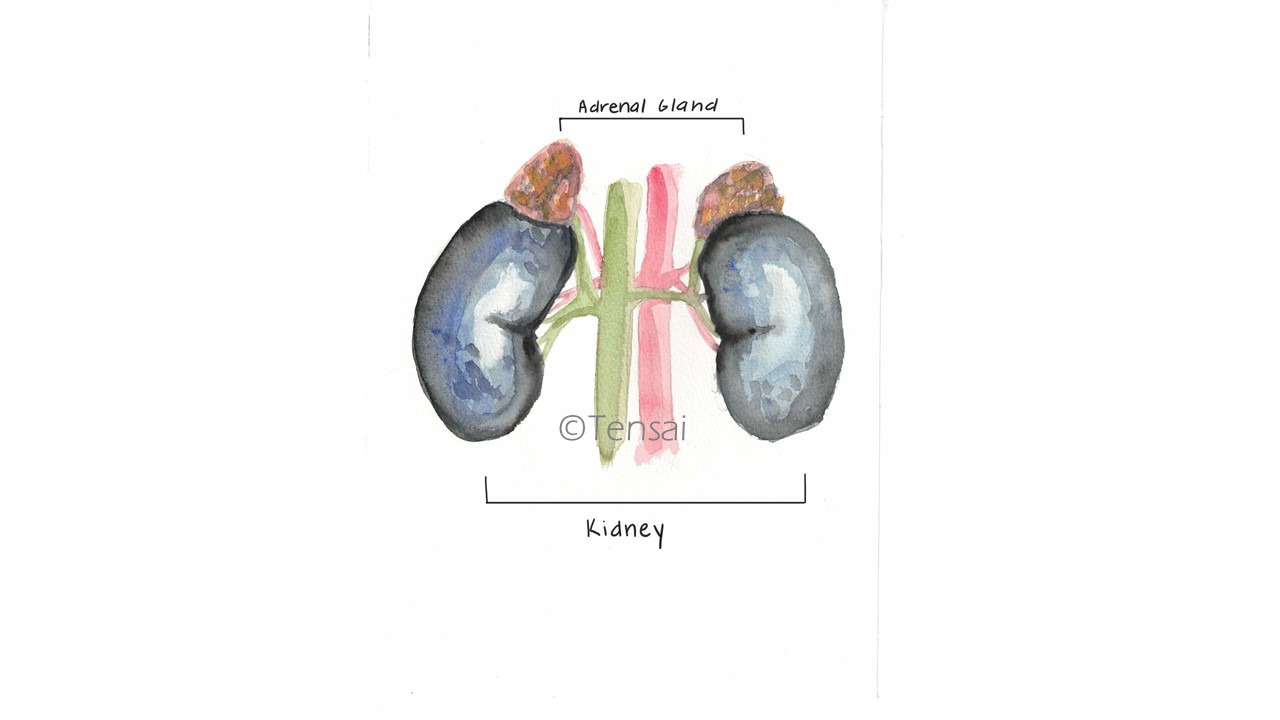
The adrenal glands are located above the kidneys.
Adrenal Medulla synthesizes and secretes epinephrine (adrenaline) and norepinephrine (noradrenaline). In a stressful situation, these hormones are released from the medulla into the blood and cause the symptoms of the fight or flight response. These symptoms include increased breathing rate heart rate, blood pressure, blood flow to the heart and muscles, conversion of glycogen to glucose in the liver, dilation of pupils; and decreased blood flow to the extremities (such as limbs).
Adrenal Cortex regulates long-term stress response. It produces three different types of hormones:
The most important of these is cortisol. Cortisol is a steroid hormone (i.e synthesized from cholesterol). Its effects last longer than adrenaline. Overall, it causes an increase in blood glucose by promoting the breakdown of muscle protein into amino acids, which are converted to glucose in the liver. Long term, though, cortisol can cause impaired thinking, heart damage, hypertension, susceptibility to infection and premature death. Synthetic cortisol (hydrocortisone) is used to treat inflammation such as that arising from allergic reactions.
Most important of these is aldosterone. It stimulates the kidneys to increase the absorption of sodium back into the blood. This increases the osmotic pressure of blood resulting in water retention, therefore increasing blood pressure.
The adrenal cortex synthesizes and secretes small amounts of sex hormones: Therefore, the adrenal cortex is a small source of testosterone, estrogen in females. Excessive production can cause early puberty in males & females, as well as masculinity in females. In females, the masculinization effect of androgen secretion may become evident after menopause, when estrogen levels from the ovaries decrease.

A detailed illustration of the adrenal gland and hormones produced by the cortex and the medulla. (Source: Wikipedia-CC BY-SA 3.0)
The thyroid gland is located at the base of the neck and in front of the trachea. It had two lobes; a left and a right. It secretes Thyroxine, a hormone whose main function is to speed up the rate of metabolism of fats, proteins and carbohydrates.
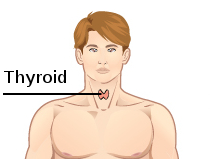
The location of the Thyroid Gland. (Source: Wikipedia-CC BY-SA 3.0)
Hyperthyroidism results in over production (hypersecretion) of thyroxine, which results in faster oxidation of sugars and other nutrients. This results in heat production, therefore affected individuals feel warmer. However, because of the increased rate of metabolism, such individuals do not gain weight easily.
Hypothyroidism is the reduced production (hyposecretion) of thyroxine. Affected individuals do not oxidize nutrients quickly enough so there is excess blood sugar, which gets converted into glycogen and excess sugars are converted into fat. Affected individuals tend to be less active, intolerant of cold, dry skin and may be overweight.
Thyroxine secretion is also regulated in a negative feedback fashion. A hormone called Thyrotropin Releasing Hormone (TRH) is produced by the Hypothalamus, it then stimulates the Pituitary gland to release Thyroid Stimulating Hormone (TSH), which then goes to the thyroid gland and stimulates the secretion of thyroxine (T4). The Thyroid Releasing Inhibitory factor is produced by the hypothalamus as well but results in the inhibition of secretion of TSH.
Iodine: There are two active forms of the thyroxine hormone i.e. Tri-iodothyronine T3 and Tetra-iodothyronine T4, which contain 3 and 4 iodine molecules respectively. T4 is approximately 65% iodine. A deficiency of iodine results in reduced production of thyroxine hormones resulting in a condition called Simple Goiter. Dietary Selenium is also essential for the metabolism of T4 and T3. Although T4 is more abundant in human blood, T3 is the active form so T4 is first converted to T3. Simple goiter, which is characterized by enlarged thyroid glands is caused by over stimulation from the pituitary gland because low T4 levels in blood means the negative feedback control is not initiated.
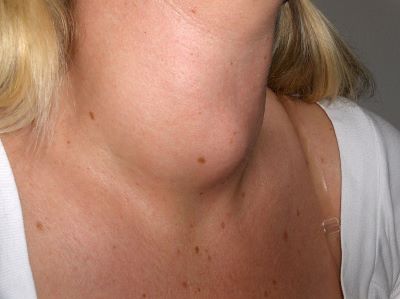
The swelling of the thyroid gland as a symptom of Goiter. (Source: Wikipedia-CC BY-SA 3.0)
Calcium: Calcium is essential in the body with functions ranging from teeth and bone formation, blood clotting, nerve function and muscle contraction. The thyroid gland also produces a hormone called Calcitonin, which increases the uptake of calcium into bones (by a type of bone cells called Osteoblasts). It is produced when there is increased calcium levels in blood. When there is low calcium levels in blood, The Parathyroid glands secrete Parathyroid hormone, which results in the breakdown of bones (by a type of bone cells called Osteoclasts). This breakdown releases calcium back into blood to return the levels of calcium to normal.
The Parathyroid Glands are four small glands located within the thyroid gland. Apart from stimulating bone desorption, the parathyroid hormone also stimulates the reabsorption of calcium in the kidneys, resulting in increased calcium retention and increased calcium levels in blood.
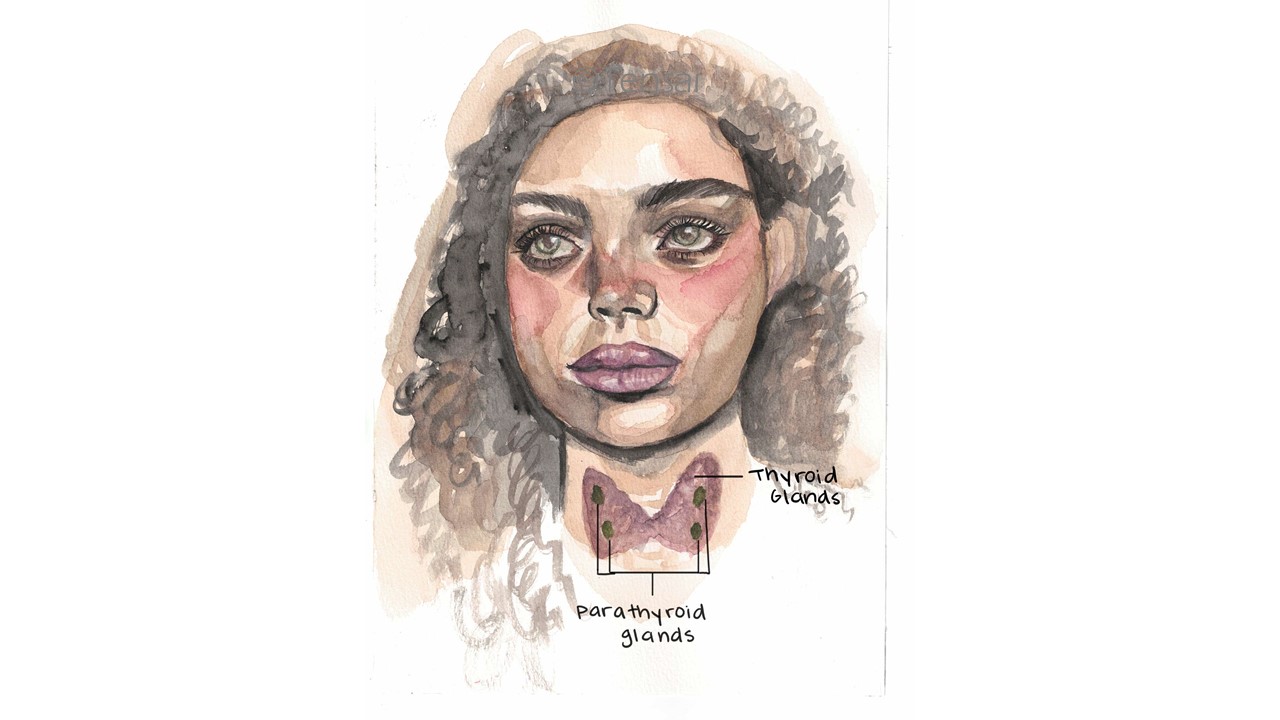
The location of the Parathyroid glands in relation to the Thyroid gland.
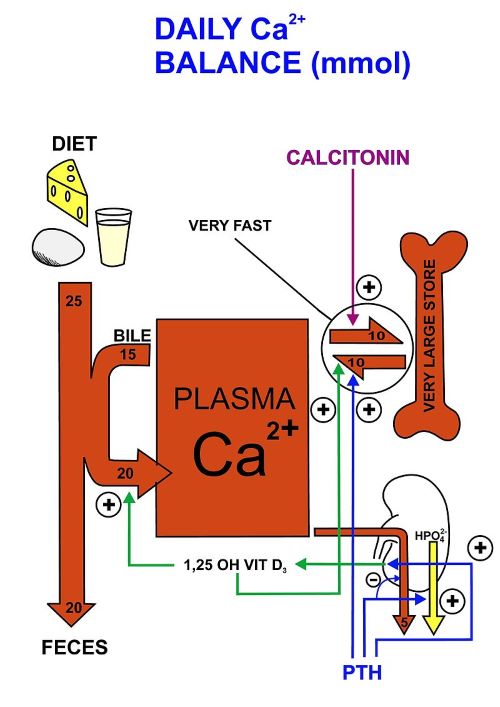
The regulation of plasma Calcium levels. (Source: Wikipedia-CC BY-SA 3.0)
| Hormone name | Endocrine gland | Type of hormone | Function |
|---|---|---|---|
| Antidiuretic hormone (ADH) | Posterior Pituitary | Peptide | Stimulates water reabsorption by kidneys, reducing urine volume. |
| Oxytocin | Posterior Pituitary | Peptide | Stimulates uterine contractions during childbirth |
| Growth hormone (GH) | Anterior Pituitary | Protein | Promotes growth of body tissues through increased cell division (in all organs of the body) and metabolism. |
| Prolactin (PRL) | Anterior Pituitary | Peptide | Promotes milk production |
| Thyroid-stimulating hormone (TSH) | Anterior Pituitary | Glycoprotein | Stimulates thyroid hormone release by the Thyroid gland |
| Adrenocorticotropic hormone (ACTH) | Anterior Pituitary | Peptide | Stimulates the adrenal cortex to release hormones such as Cortisol |
| Follicle-stimulating hormone (FSH) | Anterior Pituitary | Glycoprotein | Stimulates gamete production; in females, it stimulates development of follicles; in males it promotes development of sperms. |
| Luteinizing hormone (LH) | Anterior Pituitary | Glycoprotein | Stimulates ovulation in females, and the formation of the corpus luteum. |
| Thyroxine (T4), triiodothyronine (T3) | Thyroid gland | Amine | Stimulate basal metabolic rate |
| Calcitonin | Thyroid gland | Peptide | Reduces blood Calcium levels by (1) Inhibiting osteoclasts thus reducing bone resorption and, (2) Reducing the reabsorption of calcium in the kidneys therefore increasing calcium loss in urine. |
| Parathyroid hormone (PTH) | Parathyroid gland | Peptide | Increases blood Ca2+ levels by (1) Stimulating osteoclasts resulting in bone resorption and, (2) Increasing the reabsorption of calcium back into blood. |
| Aldosterone | Adrenal gland (cortex) | Steroid hormone | Increases blood sodium levels thereby regulating the osmotic pressure. |
| Cortisol | Adrenal gland (cortex) | Steroid | Stress response: inhibits insulin and sex hormones, thereby increasing blood glucose and fatty acid levels. |
| Cortisol | Adrenal gland (cortex) | Steroid | Stress response: inhibits insulin and sex hormones, thereby increasing blood glucose and fatty acid levels. |
| Epinephrine and norepinephrine (aka Adrenaline and Noradrenaline) | Adrenal gland (medulla) | Amine | Stimulate fight-or-flight response |
| Insulin | Pancreas | Protein | Reduces blood glucose levels by promoting absorption of glucose into the cells. |
| Glucagon | Pancreas | Protein | Increases blood glucose levels by promoting the breakdown of glycogen from the liver. |
| Testosterone | Testes (and some from adrenal cortex) | Steroid | Stimulates development of male secondary sex characteristics and sperm development. |
| Estrogen and progesterone | Ovaries | Steroid | Stimulate development of female secondary sex characteristics, stimulates sexual desire and prepare the body for childbirth |
| Melatonin | Pineal gland | Amine | Regulates sleep cycles |
| Hormone type | Description | Examples |
|---|---|---|
| Amine Hormones | Amino acids with modified side chains. For example, in Norepinephrine, the carboxyl group is replaced with a benzene ring. | Norepinephrine |
| Peptide Hormones | Short amino acid chains | Oxytocin |
| Protein hormones | Long amino acid chain | Growth Hormone |
| Steroid hormones | Synthesized from cholesterol | Estrogen / Testosterone |
You can access Tensai High School Biology revision questions HERE